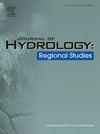Probability links between meteorological drought and hydrological drought from a 3D perspective
IF 4.7
2区 地球科学
Q1 WATER RESOURCES
引用次数: 0
Abstract
Study region
Lower Mekong River Basin (LMRB), Southeast Asia
Study focus
The links between meteorological drought (MD) and hydrological drought (HD) from a 3D perspective have not been fully investigated. A 3D identification method was employed to identify MD and HD events in the LMRB. Response of HD to MD were evaluated using linear and nonlinear models. Furthermore, the occurrence probabilities and propagation thresholds (PTs) from MD to HD were examined by applying a copula joint distribution and conditional probability based on a Bayesian network (CPBN).
New hydrological insights for the region
A total of 81 MDs and 87 HDs were identified during 1950–2021. HDs had longer durations but affected a smaller area and were less severe than MDs, with their centroids mainly located in eastern Thailand. 46 pairs of MD-HD events were matched spatiotemporally, revealing that a HD event in typical drought years could be driven by multiple MD events. The duration, area, and severity of these drought pairs were optimally fitted using linear, 3P-power, and polynomial function models, respectively. Additionally, the occurrence probabilities of moderate, severe, and extreme HDs successively decreased under the same MD conditions. The PT from MD to HD increased with increasing severity levels of HDs. The study of the links between MD and HD from a 3D perspective provides a more comprehensive understanding of drought in the LMRB.
从三维角度看气象干旱与水文干旱之间的概率联系
研究区域东南亚湄公河下游流域(LMRB)研究重点尚未从三维角度充分研究气象干旱(MD)与水文干旱(HD)之间的联系。采用三维识别方法识别了 LMRB 中的 MD 和 HD 事件。使用线性和非线性模型评估了 HD 对 MD 的响应。此外,通过应用基于贝叶斯网络的 copula 联合分布和条件概率 (CPBN),研究了从 MD 到 HD 的发生概率和传播阈值 (PTs)。HD 持续时间较长,但影响范围较小,严重程度低于 MD,其中心点主要位于泰国东部。46 对 MD-HD 事件进行了时空匹配,揭示了典型干旱年份的 HD 事件可能是由多个 MD 事件驱动的。这些干旱事件对的持续时间、面积和严重程度分别用线性、3P-幂和多项式函数模型进行了最佳拟合。此外,在相同的 MD 条件下,中度、重度和极端 HD 的发生概率依次降低。从 MD 到 HD 的 PT 随 HD 严重程度的增加而增加。从三维角度研究MD与HD之间的联系,可以更全面地了解LMRB的干旱情况。
本文章由计算机程序翻译,如有差异,请以英文原文为准。
求助全文
约1分钟内获得全文
求助全文
来源期刊

Journal of Hydrology-Regional Studies
Earth and Planetary Sciences-Earth and Planetary Sciences (miscellaneous)
CiteScore
6.70
自引率
8.50%
发文量
284
审稿时长
60 days
期刊介绍:
Journal of Hydrology: Regional Studies publishes original research papers enhancing the science of hydrology and aiming at region-specific problems, past and future conditions, analysis, review and solutions. The journal particularly welcomes research papers that deliver new insights into region-specific hydrological processes and responses to changing conditions, as well as contributions that incorporate interdisciplinarity and translational science.
 求助内容:
求助内容: 应助结果提醒方式:
应助结果提醒方式:


